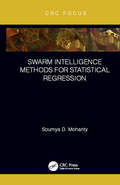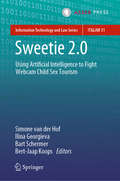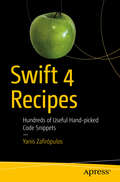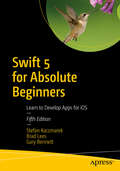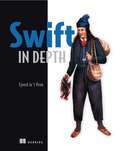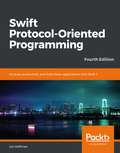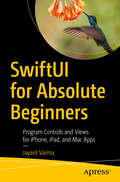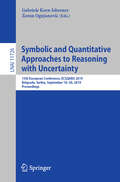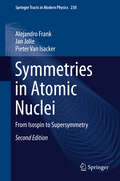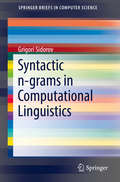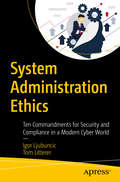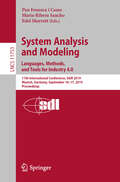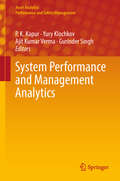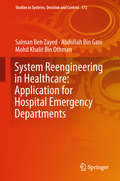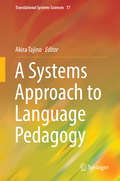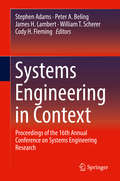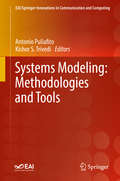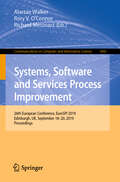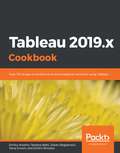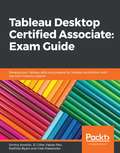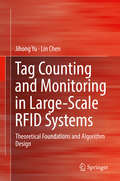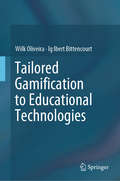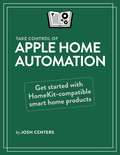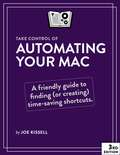- Table View
- List View
Sustainable Manufacturing and Remanufacturing Management: Process Planning, Optimization and Applications
by Weidong Li Sheng WangThis book reports on the latest research and applications in the fields of sustainable manufacturing and remanufacturing, as well as process planning and optimization technologies. It introduces innovative algorithms, methodologies, industrial case studies and applications.It focuses on two topics: sustainable manufacturing for machining technologies and remanufacturing of waste electronic equipment, and various methods are covered for each one, including macro process planning, dynamic scheduling, selective disassembly planning and cloud-based disassembly planning. The experimental analysis provided for every method explains the benefits, as well as how they are sustainable for various real-world applications. Further, a theoretical analysis and algorithm design is presented for each, accompanied by the contributors’ relevant research, including:• step-by-step guides; • application scenarios; • relevant literature surveys; • implementation details and case studies; and • critical reviews on the relevant technologies.This book is a valuable resource for researchers in sustainable manufacturing, remanufacturing and product lifecycle management communities, as well as practicing engineers and decision-makers in industry and all those interested in sustainable product development. It is also useful reading material for postgraduates and academics wanting to conduct relevant research, and a reference resource for manufacturing engineers developing innovative tools and methodologies.
Swarm Intelligence Methods for Statistical Regression
by Soumya MohantyA core task in statistical analysis, especially in the era of Big Data, is the fitting of flexible, high-dimensional, and non-linear models to noisy data in order to capture meaningful patterns. This can often result in challenging non-linear and non-convex global optimization problems. The large data volume that must be handled in Big Data applications further increases the difficulty of these problems. Swarm Intelligence Methods for Statistical Regression describes methods from the field of computational swarm intelligence (SI), and how they can be used to overcome the optimization bottleneck encountered in statistical analysis. Features Provides a short, self-contained overview of statistical data analysis and key results in stochastic optimization theory Focuses on methodology and results rather than formal proofs Reviews SI methods with a deeper focus on Particle Swarm Optimization (PSO) Uses concrete and realistic data analysis examples to guide the reader Includes practical tips and tricks for tuning PSO to extract good performance in real world data analysis challenges
Sweetie 2.0: Using Artificial Intelligence to Fight Webcam Child Sex Tourism (Information Technology and Law Series #31)
by Simone van der Hof Ilina Georgieva Bart Schermer Bert-Jaap KoopsThis book centres on Webcam Child Sex Tourism and the Sweetie Project initiated by the children’s rights organization Terre des Hommes in 2013 in response to the exponential increase of online child abuse. Webcam child sex tourism is a growing international problem, which not only encourages the abuse and sexual exploitation of children and provides easy access to child-abuse images, but which is also a crime involving a relatively low risk for offenders as live-streamed webcam performances leave few traces that law enforcement can use. Moreover, webcam child sex tourism often has a cross-border character, which leads to jurisdictional conflicts and makes it even harder to obtain evidence, launch investigations or prosecute suspects.Terre des Hommes set out to actively tackle webcam child sex tourism by employing a virtual 10-year old Philippine girl named Sweetie, a so-called chatbot, to identify offenders in chatrooms. Sweetie 1.0 could be deployed only if police officers participated in chats, and thus was limited in dealing with the large number of offenders. With this in mind, a more pro-active and preventive approach was adopted to tackle the issue. Sweetie 2.0 was developed with an automated chat function to track, identify and deter individuals using the internet to sexually abuse children. Using chatbots allows the monitoring of larger parts of the internet to locate and identify (potential) offenders, and to send them messages to warn of the legal consequences should they proceed further.But using artificial intelligence raises serious legal questions. For instance, is sexually interacting with a virtual child actually a criminal offence? How do rules of criminal procedure apply to Sweetie as investigative software? Does using Sweetie 2.0 constitute entrapment? This book, the outcome of a comparative law research initiative by Leiden University’s Center for Law and Digital Technologies (eLaw) and the Tilburg Institute for Law, Technology, and Society (TILT), addresses the application of substantive criminal law and criminal procedure to Sweetie 2.0 within various jurisdictions around the world.This book is especially relevant for legislators and policy-makers, legal practitioners in criminal law, and all lawyers and academics interested in internet-related sexual offences and in Artificial Intelligence and law.Professor Simone van der Hof is General Director of Research at t he Center for Law and Digital Technologies (eLaw) of the Leiden Law School at Leiden University, The Netherlands. Ilina Georgieva, LL.M., is a PhD researcher at the Faculty of Governance and Global Affairs at Leiden University, Bart Schermer is an associate professor at the Center for Law and Digital Technologies (eLaw) of the Leiden Law School, and Professor Bert-Jaap Koops is Professor of Regulation and Technology at the Tilburg Institute for Law, Technology, and Society (TILT), Tilburg University, The Netherlands.
Swift 4 Recipes
by Yanis ZafirópulosGet the most out of Swift 4 with this carefully compiled collection of select code snippets designed to solve everyday coding problems. This book features the Apress easy-to-use recipe format, with step-by-step instructions, and a no-fuss approach. You'll explore a wide range of topics, all neatly organized according to the language’s own core elements and building blocks. You'll review common topics such as conditionals, loops, functions, classes, closures, and arrays. This book also includes recipes to some more advanced problems found in files, system programming, and algorithms. With Swift 4 Recipes, your programming problems are easily resolved, without wading through paragraphs of text. What You'll LearnCreate if-switch statements, ternary operator, and nil-coalescing Work with numbers, conversions, mathematical functions Access the command line and retrieving system infoWho This Book Is ForMac and iOS developers either looking for a quick problem-solution manual to get started or in search of a quick reference for everyday problems in a dictionary-like fashion.
Swift 5 for Absolute Beginners: Learn to Develop Apps for iOS
by Stefan Kaczmarek Brad Lees Gary BennettStay motivated and overcome obstacles while learning to use Swift Playgrounds and Xcode 10.2 to become a great iOS developer. This book, fully updated for Swift 5, is perfect for those with no programming background, those with some programming experience but no object-oriented experience, or those that have a great idea for an app but haven’t programmed since school.Many people have a difficult time believing they can learn to write iOS apps. Swift 5 for Absolute Beginners will show you how to do so. You'll learn Object-Oriented Programming (OOP) and be introduced to User Interface (UI) design following Apple’s Human Interface Guidelines (HIG) using storyboards and the Model-View-Controller (MVC) pattern before moving on to write your own iPhone and Apple Watch apps from scratch.What You’ll LearnWork with Swift classes, properties, and functionsExamine proper User Interface (UI) and User Experience (UX) designUnderstand Swift data types: integers, floats, strings, and booleansUse Swift data collections: arrays and dictionariesReview Boolean logic, comparing data, and flow controlUse the Xcode debugger to troubleshoot problems with your appsStore data in local app preferences and Core Data databases Who This Book Is ForAnyone who wants to learn to develop apps for the Mac, iPhone, iPad, and Apple Watch using the Swift programming language. No previous programming experience is necessary.
Swift in Depth
by Tjeerd in 't VeenSummary Now updated for Swift 5! Swift is more than just a fun language to build iOS applications with. It features a host of powerful tools that, if effectively used, can help you create even better apps with clean, crystal-clear code and awesome features. Swift in Depth is designed to help you unlock these tools and quirks and get developing next-gen apps, web services, and more! Purchase of the print book includes a free eBook in PDF, Kindle, and ePub formats from Manning Publications. About the Technology It's fun to create your first toy iOS or Mac app in Swift. Writing secure, reliable, professional-grade software is a different animal altogether. The Swift language includes an amazing set of high-powered features, and it supports a wide range of programming styles and techniques. You just have to roll up your sleeves and learn Swift in depth. About the Book Swift in Depth guides you concept by concept through the skills you need to build professional software for Apple platforms, such as iOS and Mac; also on the server with Linux. By following the numerous concrete examples, enlightening explanations, and engaging exercises, you'll finally grok powerful techniques like generics, efficient error handling, protocol-oriented programming, and advanced Swift patterns. Author Tjeerd in 't Veen reveals the high-value, difficult-to-discover Swift techniques he's learned through his own hard-won experience. What's inside Covers Swift 5 Writing reusable code with generics Iterators, sequences, and collections Protocol-oriented programming Understanding map, flatMap, and compactMap Asynchronous error handling with ResultBest practices in Swift About the Reader Written for advanced-beginner and intermediate-level Swift programmers. About the Author Tjeerd in 't Veen is a senior software engineer and architect in the mobile division of a large international banking firm. Table of Contents Introducing Swift in depth Modeling data with enums Writing cleaner properties Making optionals second nature Demystifying initializers Effortless error handling Generics Putting the pro in protocol-oriented programming Iterators, sequences, and collections Understanding map, flatMap, and compactMap Asynchronous error handling with Result Protocol extensions Swift patterns Delivering quality Swift code Where to Swift from here
Swift Protocol-Oriented Programming: Increase productivity and build faster applications with Swift 5, 4th Edition
by Jon HoffmanEmbrace the Protocol-Oriented Programming paradigm, for better code maintainability and increased performance, with Swift programming. Key Features Leverage the power of Protocol-Oriented Programming in your applications Leverage generics to create very flexible frameworks Learn how to implement common design patterns in a protocol-oriented way Book Description Protocol-oriented programming is an incredibly powerful concept at the heart of Swift's design. Swift's standard library was developed using POP techniques, generics, and first-class value semantics; therefore, it is important for every Swift developer to understand these core concepts and take advantage of them. The fourth edition of this book is improved and updated to the latest version of the Swift programming language. This book will help you understand what protocol-oriented programming is all about and how it is different from other programming paradigms such as object-oriented programming. This book covers topics such as generics, Copy-On-Write, extensions, and of course protocols. It also demonstrates how to use protocol-oriented programming techniques via real-world use cases. By the end of this book, you will know how to use protocol-oriented programming techniques to build powerful and practical applications. What you will learn Learn the differences between object-oriented programming and protocol-oriented programming Understand why value types should be prioritized over reference types Delve into protocols, protocol inheritance, protocol composition, and protocol extensions Learn how to implement COW (Copy-On-Write) within your custom value types Understand how memory management works in Swift and how to avoid common pitfalls Design applications by starting with the protocol rather than the implementation Who this book is for This book is intended for Swift developers who have, at minimum an introductory knowledge of the Swift programming language and would like to understand how they can use Protocol-Oriented Programming techniques in their applications.
SwiftUI for Absolute Beginners: Program Controls and Views for iPhone, iPad, and Mac Apps
by Jayant VarmaDive into the world of developing for all of Apple platforms with SwiftUI, Apple’s new framework that makes writing applications faster and easier with fewer lines of code. This book teaches the basics of SwiftUI to help you write amazing native applications using XCode.For developers already familiar with ReactNative, this book reviews the declarative, state-based DSL that manages the UI and updates it automatically will feel just like what they’re used to. You'll see how SwiftUI reduces the number of lines of code required to achieve the same effects by over 60% and provides a much better experience. Like the announcement of Swift in 2014, SwiftUI is expected to fundamentally change the way developing programmers approach coding iPhone and iPad applications. This book examines how SwiftUI lowers the entry barrier for developers to write amazing cross-platform applications for iOS and iPadOS as well as WatchOS, Mac OS, and TVOS. What You'll LearnWrite code in the new SwiftUI syntaxCombine views to arrange them for an applicationAdd gestures and controls to an applicationWho This Book Is ForAnyone who wants to learn to develop apps for the Mac, iPhone, iPad, and Apple Watch using the Swift programming language. No previous programming experience is necessary.
Symbolic and Quantitative Approaches to Reasoning with Uncertainty: 15th European Conference, ECSQARU 2019, Belgrade, Serbia, September 18-20, 2019, Proceedings (Lecture Notes in Computer Science #11726)
by Gabriele Kern-Isberner Zoran OgnjanovićThis book constitutes the refereed proceedings of the 15th European Conference on Symbolic and Quantitative Approaches to Reasoning with Uncertainty, ECSQARU 2019, held in Belgrade, Serbia, in September 2019.The 41 full papers presented together with 3 abstracts of invited talks inn this volume were carefully reviewed and selected from 62 submissions. The papers are organized in topical sections named: Argumentation; Belief Functions; Conditional, Default and Analogical Reasoning; Learning and Decision Making; Precise and Imprecise Probabilities; and Uncertain Reasoning for Applications.
Symmetries in Atomic Nuclei: From Isospin to Supersymmetry (Springer Tracts in Modern Physics #230)
by Alejandro Frank Jan Jolie Pieter Van IsackerThe revised edition of this established work presents an extended overview of recent applications of symmetry to the description of atomic nuclei, including a pedagogical introduction to symmetry concepts using simple examples. Following a historical overview of the applications of symmetry in nuclear physics, attention turns to more recent progress in the field. Special emphasis is placed on the introduction of neutron-proton and boson-fermion degrees of freedom. Their combination leads to a supersymmetric description of pairs and quartets of nuclei. Expanded and updated throughout, the book now features separate chapters on the nuclear shell model and the interacting boson model, the former including discussion of recent results on seniority in a single-j shell. Both theoretical aspects and experimental signatures of dynamical (super)symmetries are carefully discussed. This book focuses on nuclear structure physics, but its broad scope makes it suitable for final-year or post-graduate students and researchers interested in understanding the power and beauty of symmetry methods in physics.Review of the 1st Edition:"The subject of this book, symmetries in physical systems, with particular focus on atomic nuclei, is of the utmost importance in modern physical science. In contrast to most treatments, frequently characterized by fearsome formalism, this book leads the reader step-by-step, in an easily understandable way, through this fascinating field...this book is remarkably accessible to both theorists and experimentalists. Indeed, I view it as essential reading for experimental nuclear structure physicists. This is one of the finest volumes on this subject I have ever encountered." Prof. R.F. Casten, Yale University
Syntactic n-grams in Computational Linguistics (SpringerBriefs in Computer Science)
by Grigori SidorovThis book is about a new approach in the field of computational linguistics related to the idea of constructing n-grams in non-linear manner, while the traditional approach consists in using the data from the surface structure of texts, i.e., the linear structure.In this book, we propose and systematize the concept of syntactic n-grams, which allows using syntactic information within the automatic text processing methods related to classification or clustering. It is a very interesting example of application of linguistic information in the automatic (computational) methods. Roughly speaking, the suggestion is to follow syntactic trees and construct n-grams based on paths in these trees. There are several types of non-linear n-grams; future work should determine, which types of n-grams are more useful in which natural language processing (NLP) tasks. This book is intended for specialists in the field of computational linguistics. However, we made an effort to explain in a clear manner how to use n-grams; we provide a large number of examples, and therefore we believe that the book is also useful for graduate students who already have some previous background in the field.
System Administration Ethics: Ten Commandments for Security and Compliance in a Modern Cyber World
by Igor Ljubuncic Tom LittererSuccessfully navigate through the ever-changing world of technology and ethics and reconcile system administration principles for separation of duty, account segmentation, administrative groups and data protection. As security breaches become more common, businesses need to protect themselves when facing ethical dilemmas in today’s digital landscape. This book serves as a equitable guideline in helping system administrators, engineers – as well as their managers – on coping with the ethical challenges of technology and security in the modern data center by providing real-life stories, scenarios, and use cases from companies both large and small. You'll examine the problems and challenges that people working with customer data, security and system administration may face in the cyber world and review the boundaries and tools for remaining ethical in an environment where it is so easy to step over a line - intentionally or accidentally. You'll also see how to correctly deal with multiple ethical situations, problems that arise, and their potential consequences, with examples from both classic and DevOps-based environments.Using the appropriate rules of engagement, best policies and practices, and proactive “building/strengthening” behaviors, System Administration Ethics provides the necessary tools to securely run an ethically correct environment. What You'll LearnThe concepts of Least Privilege and Need to KnowRequest change approval and conduct change communicationFollow "Break Glass" emergency proceduresCode with data breaches, hacking and security violations, and proactively embrace and design for failures Build and gain trust with employees and build the right ethical cultureReview what managers can do to improve ethics and protect their employeesWho This Book Is ForThis book’s primary audience includes system administrators and information security specialists engaged with the creation, process and administration of security policies and systems. A secondary audience includes company leaders seeking to improve the security, privacy, and behavioral practices.
System Analysis and Modeling. Languages, Methods, and Tools for Industry 4.0: 11th International Conference, SAM 2019, Munich, Germany, September 16–17, 2019, Proceedings (Lecture Notes in Computer Science #11753)
by Pau Fonseca i Casas Maria-Ribera Sancho Edel SherrattThis book constitutes the refereed proceedings of the 11th International Conference on System Analysis and Modeling, SAM 2019, held in Munich, Germany, in September 2019.The 12 full papers and 2 work in progress papers presented together with one keynote talk were carefully reviewed and selected from 28 submissions. The papers discuss the most recent innovations, trends, and experiences in modeling and analysis of complex systems using ITU-T's Specification and Description Language (SDL-2010) and Message Sequence Chart (MSC) notations, as well as related system design languages — including UML, ASN.1, TTCN, SysML, and the User Requirements Notation (URN). SAM 2019’s theme was “Languages, Methods, and Tools for Industry 4.0.”
System Performance and Management Analytics (Asset Analytics)
by P. K. Kapur Yury Klochkov Ajit Kumar Verma Gurinder SinghThis book shares key insights into system performance and management analytics, demonstrating how the field of analytics is currently changing and how it is used to monitor companies’ efforts to drive performance.Managing business performance facilitates the effective accomplishment of strategic and operational goals, and there is a clear and direct correlation between using performance management applications and improved business and organizational results. As such, performance and management analytics can yield a range of direct and indirect benefits, boost operational efficiency and unlock employees’ latent potential, while at the same time aligning services with overarching goals.The book addresses a range of topics, including software reliability assessment, testing, quality management, system-performance management, analysis using soft-computing techniques, and management analytics. It presents a balanced, holistic approach to viewing the world from both a technical and managerial perspective by considering performance and management analytics. Accordingly, it offers a comprehensive guide to one of the most pressing issues in today’s technology-dominated world, namely, that most companies and organizations find themselves awash in a sea of data, but lack the human capital, appropriate tools and knowledge to use it to help them create a competitive edge.
System Reengineering in Healthcare: Application for Hospital Emergency Departments (Studies in Systems, Decision and Control #172)
by Salman Ben Zayed Abdullah Bin Gani Mohd Khalit Bin OthmanThis book presents an advanced systematic mapping review (SMR) and state-of-the-art taxonomy of emergency departments (EDs). Focusing on the patients’ level of fulfilment and how it can be enhanced, it examines existing problems like waiting periods and overcrowding and how these can be alleviated to provide a better service. The author examined research papers from 1964 to 2018, and developed six research questions, organising them using mapping studies, the primary objectives of which were firstly, to obtain a common understanding of the problems that need to be highlighted in EDs, and secondly, to re-analyse the methods used. Focusing on quality, the book encourages citations of experimental methods from important studies concerning EDs that can improve services. Through different research papers, various thematic areas in the healthcare sector were examined, like the determination of the relative efficiency of pre-discharge interventions; the analysis of care and managing common indications during the last stages of life; using e-Health to enhance effectiveness and proficiency; the seriousness of patient differences among EDs; the identification of quality problems in healthcare contexts; existing opportunities and the suggested plans. The book concludes that an analytical decision-making process should be used to assess a health technology on the basis of its performance. It stresses the importance of updating this analytical system frequently.
A Systems Approach to Language Pedagogy (Translational Systems Sciences #17)
by Akira TajinoThis volume represents the first attempt in the field of language pedagogy to apply a systems approach to issues in English language education. In the literature of language education, or more specifically, second or foreign language learning and teaching, each topic or issue has often been dealt with independently, and been treated as an isolated item. Taking grammar instruction as an example, grammatical items are often taught in a sequential, step-by-step manner; there has been no “road map” in which the interrelations between the various items are demonstrated. This may be one factor that makes it more difficult for students to learn the language organically. The topics covered in this volume, including language acquisition, pedagogical grammar, and teacher collaboration, are viewed from a holistic perspective. In other words, language pedagogy is approached as a dynamic system of interrelations. In this way, “emergent properties” are expected to manifest. This book is recommended for anyone involved in language pedagogy, including researchers, teachers, and teacher trainers, as well as learners.
Systems Engineering in Context: Proceedings of the 16th Annual Conference on Systems Engineering Research
by William T. Scherer James H. Lambert Stephen Adams Peter A. Beling Cody H. FlemingThis volume chronicles the 16th Annual Conference on System Engineering Research (CSER) held on May 8-9, 2018 at the University of Virginia, Charlottesville, Virginia, USA. The CSER offers researchers in academia, industry, and government a common forum to present, discuss, and influence systems engineering research. It provides access to forward‐looking research from across the globe, by renowned academicians as well as perspectives from senior industry and government representatives. Co‐founded by the University of Southern California and Stevens Institute of Technology in 2003, CSER has become the preeminent event for researchers in systems engineering across the globe. Topics include though are not limited to the following: Systems in context: · Formative methods: requirements · Integration, deployment, assurance · Human Factors · Safety and Security Decisions/ Control & Design; Systems Modeling: · Optimization, Multiple Objectives, Synthesis · Risk and resiliency · Collaborative autonomy · Coordination and distributed decision-making Prediction: · Prescriptive modeling; state estimation · Stochastic approximation, stochastic optimization and control Integrative Data engineering: · Sensor Management · Design of Experiments
Systems Modeling: Methodologies and Tools (EAI/Springer Innovations in Communication and Computing)
by Antonio Puliafito Kishor S. TrivediThis book covers ideas, methods, algorithms, and tools for the in-depth study of the performance and reliability of dependable fault-tolerant systems. The chapters identify the current challenges that designers and practitioners must confront to ensure the reliability, availability, and performance of systems, with special focus on their dynamic behaviors and dependencies. Topics include network calculus, workload and scheduling; simulation, sensitivity analysis and applications; queuing networks analysis; clouds, federations and big data; and tools. This collection of recent research exposes system researchers, performance analysts, and practitioners to a spectrum of issues so that they can address these challenges in their work.
Systems, Software and Services Process Improvement: 26th European Conference, EuroSPI 2019, Edinburgh, UK, September 18–20, 2019, Proceedings (Communications in Computer and Information Science #1060)
by Alastair Walker Rory V. O’Connor Richard MessnarzThis volume constitutes the refereed proceedings of the 26th European Conference on Systems, Software and Services Process Improvement, EuroSPI conference, held in Edinburgh, Scotland, in September 2019. The 18 revised full papers presented were carefully reviewed and selected from 28 submissions. They are organized in topical sections: Visionary Papers, SPI and Safety and Security, SPI and Assessments, SPI and Future Qualification & Team Performance, and SPI Manifesto and Culture. The selected workshop papers are also presented and organized in following topical sections: GamifySPI, Digitalisation of Industry, Infrastructure and E-Mobility. -Best Practices in Implementing Traceability. -Good and Bad Practices in Improvement. -Functional Safety and Cybersecurity. -Experiences with Agile and Lean. -Standards and Assessment Models. -Team Skills and Diversity Strategies. -Recent Innovations.
Tableau 2018.1 Cookbook: Over 115 recipes to build end-to-end analytical solutions using Tableau
by Dmitry Anoshin Teodora Matic Slaven Bogdanovic Tania Lincoln Kunal AroraThis book is for data analysts, data visualization and BI users who are looking for quick solutions to common and not-so-common problems faced while using Tableau. Put each recipe into practice by bringing the latest offerings of Tableau 2018.x to solve real-world analytics and business intelligence challenges. Some understanding of BI concepts and Tableau is required
Tableau Desktop Certified Associate: Develop your Tableau skills and prepare for Tableau certification with tips from industry experts
by Dmitry Anoshin JC Gillet Fabian Peri Radhika Biyani Gleb MakarenkoLearn through hands-on exercises covering a variety of topics including data connections, analytics, and dashboards to effectively prepare for the Tableau Desktop Certified Associate exam Key Features Prepare for the Tableau Desktop Certified Associate exam with the help of tips and techniques shared by experts Implement Tableau's advanced analytical capabilities such as forecasting Delve into advanced Tableau features and explore best practices for building dashboards Book Description The Tableau Desktop Certified Associate exam measures your knowledge of Tableau Desktop and your ability to work with data and data visualization techniques. This book will help you to become well-versed in Tableau software and use its business intelligence (BI) features to solve BI and analytics challenges. With the help of this book, you'll explore the authors' success stories and their experience with Tableau. You'll start by understanding the importance of Tableau certification and the different certification exams, along with covering the exam format, Tableau basics, and best practices for preparing data for analysis and visualization. The book builds on your knowledge of advanced Tableau topics such as table calculations for solving problems. You'll learn to effectively visualize geographic data using vector maps. Later, you'll discover the analytics capabilities of Tableau by learning how to use features such as forecasting. Finally, you'll understand how to build and customize dashboards, while ensuring they convey information effectively. Every chapter has examples and tests to reinforce your learning, along with mock tests in the last section. By the end of this book, you'll be able to efficiently prepare for the certification exam with the help of mock tests, detailed explanations, and expert advice from the authors. What you will learn Apply Tableau best practices to analyze and visualize data Use Tableau to visualize geographic data using vector maps Create charts to gain productive insights into data and make quality-driven decisions Implement advanced analytics techniques to identify and forecast key values Prepare customized table calculations to compute specific values Answer questions based on the Tableau Desktop Certified Associate exam with the help of mock tests Who this book is for This Tableau certification book is for business analysts, BI professionals, and data analysts who want to become certified Tableau Desktop Associates and solve a range of data science and business intelligence problems using this example-packed guide. Some experience in Tableau Desktop is expected to get the most out of this book.
Tag Counting and Monitoring in Large-Scale RFID Systems: Theoretical Foundations and Algorithm Design
by Jihong Yu Lin ChenThis book provides a comprehensive treatment of the theoretical foundation and algorithmic tools necessary in the design of efficient tag counting and monitoring algorithms in emerging RFID systems. The book delivers an in-depth analysis on the following problems ranging from theoretical modeling and analysis, to practical algorithm design and optimization: Stability analysis of the frame slotted Aloha protocol, the de facto standard in RFID tag counting and identification; Tag population estimation in dynamic RFID systems; Missing tag event detection in the presence of unexpected tags; Missing tag event detection in multi-group multi-region RFID systems. The target readers are researchers and advanced-level engineering students interested in acquiring in-depth knowledge on the topic and on RFID systems and their applications.
Tailored Gamification to Educational Technologies
by Wilk Oliveira Ig Ibert BittencourtThis book introduces and explores the field of tailored gamified educational technologies. Providing a theoretical overview of the domain, including a number of related psychological and educational theories along with a complete state-of-the-art analysis on this topic, it presents an approach and architecture to tailor these systems to students’ gamer type and age.
Take Control of Apple Home Automation
by Josh CentersThanks to Apple's HomeKit platform, you can easily configure smart home devices (such as light bulbs, outlets, thermostats, sensors, cameras, and door locks) from a variety of manufacturers to behave exactly as you need them to; integrate them with a hub such as a HomePod, Apple TV, or iPad; and control them with an iOS device, a Mac, an Apple Watch, Siri commands, or automated programming. This book gives you all the information you need to get started.
Take Control of Automating Your Mac
by Joe KissellEver wondered if automation could make your life easier? In "Take Control of Automating Your Mac, Third Edition," Mac expert Joe Kissell shows you how to save time and aggravation by using numerous built-in macOS tools, as well as helpful third-party apps, to automate routine tasks and procedures.

